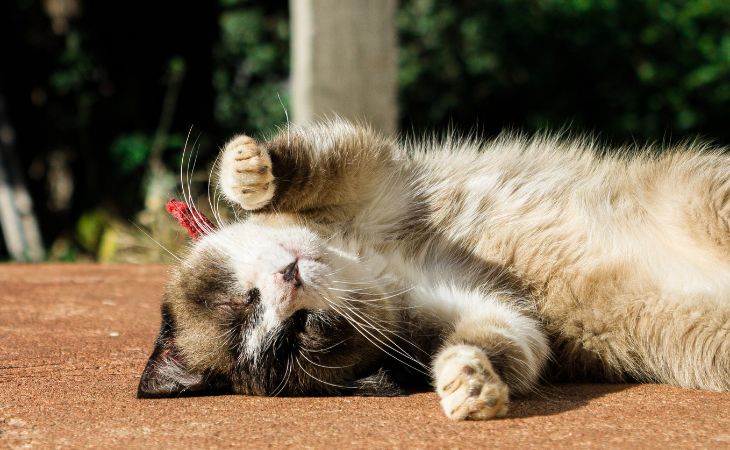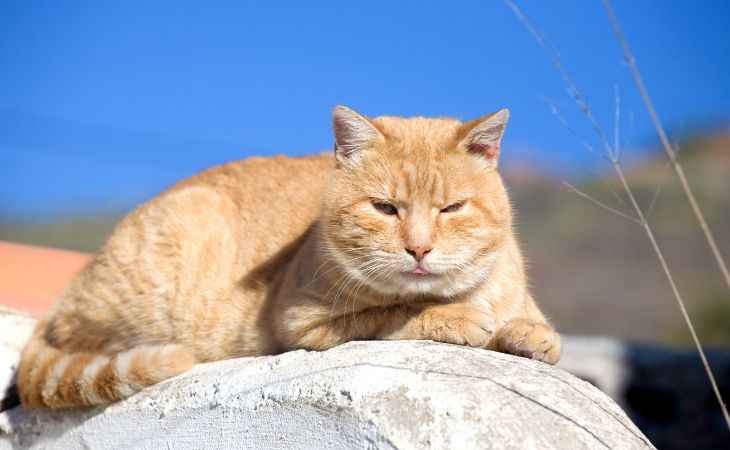When we think of summer, we often think of vacations, sun, and heat. However, this hot season also comes with increased risks for our pets. While dogs are more often mentioned in heat stroke prevention campaigns, cats are not immune to suffering from it as well. Heat stroke in cats is less visible and more discreet, but it can have dramatic consequences if not detected and treated quickly. So, how do you recognize and prevent it, and what should you do in an emergency? Read on to find out!
What is heat stroke in cats?
Heat stroke, also known as hyperthermia, happens when a cat’s body temperature exceeds their body’s ability to regulate it. A cat’s body temperature is normally between 38 and 39°C (≈ 100.4°F and 102.2°F). However, if it reaches above 40°C (≈ 104°F), it can be referred to as severe hyperthermia. Unfortunately, this abnormal rise in temperature can be fatal if not treated quickly.
Unlike humans, cats’ bodies don’t sweat. Instead, their only effective method of thermal regulation is to pant, lick, or seek a cool area to hang out in. If these fail, the risk of heat stroke is real.
Possible causes of heat stroke in cats
Several situations can cause heat stroke in cats, including :
- A hot and poorly ventilated environment, such as a closed room exposed to direct sunlight, or a car.
- Lack of access to fresh water, which prevents proper hydration.
- Prolonged exposure to the sun, especially for cats who like to lounge on windowsills or terraces.
- Stress or intense physical activity in a hot environment.
- A dense or dark coat, which retains more heat.
- Medical or physiological predispositions: cats that are elderly, obese, brachycephalic (like Persian cats), or suffering from heart or respiratory problems are more at risk.
What are the symptoms of a heat stroke in cats?
The signs of heat stroke can appear quickly. Here are the main symptoms to watch out for:
- Excessive panting (your cat breathes with their mouth open, which is abnormal for them)
- Heavy salivation
- A dark red or purplish tongue
- Apathy, weakness, difficulty standing upright
- Vomiting or diarrhea
- Tremors or convulsions
- Loss of consciousness in severe cases
A cat with these symptoms needs to be taken to the vet immediately.
What should I do if my cat is suffering from a heat stroke?
If your cat is having a heat stroke, every minute counts. Here are the actions you should adopt immediately:
- Place your cat in a cool space immediately, this should be in the shade and in a well-ventilated area.
- Cool them down progressively. This is done to avoid provoking thermal shock. To do this:
- Apply a wet cloth (room temperature) on their body, focus on their paw pads, the belly, and the underarms.
- Use a fan or air conditioning if possible.
- Do not plunge them into ice water, this can worsen their condition.
- Keep your cat hydrated. If they are still conscious, propose fresh water without forcing them to drink.
- Consult a vet urgently. Even if your cat seems to be doing better, medical surveillance is necessary. Internal after-effects may occur.

How do I prevent my cat from getting a heat stroke?
The best way to protect your cat is to anticipate the risks. Here are a few simple and useful tips.
1) Provide your cat with a cool environment
- Leave the doors of many rooms open so that your cat can choose the coolest area to hang out in.
- Close the shades or curtains during the hottest hours of the day.
- Use a fan or air conditioning if possible.
2) Make sure they always have easy access to water
- Place several bowls of fresh water around the house.
- Change the water regularly, especially during heat waves
- Some cats drink more with a water fountain.
3) Take care of your cat’s coat
- Brush your cat regularly to get rid of excess hair.
- A wet glove or towel can be passed on their coat to help them stay cool.
4) Limit your cat’s physical activity when it’s hot out
- Avoid intense physical activity and exercise during the hottest hours of the day.
- If your cat typically goes outside, it’s best to limit their outings to the coolest hours (early morning and the evenings).
5) Be careful with vulnerable cats
- It’s important to pay particular attention to senior, obese, or sick cats.
- If you are unsure, do not hesitate to ask for tips from your vet.
This Letsgetpet article might also interest you: How to protect your cat from the heat
Heat stroke in cats: a real but avoidable danger
Heat stroke is a vet emergency that can have serious consequences if not treated quickly. Because cats are often discreet when it come to their suffering, they can unfortunately suffer in silence. However, if you adopt the right reflexes and remain vigilant and careful, especially in hot weather, you can avoid the worst and guarantee the well-being of your four-legged friend.
FAQ : heat stroke in cats
My cat doesn’t go outside. Can they still get heat stroke?
Yes. Even indoors! When a cat stays in a very hot environment or is in one that is not well-ventilated, it can cause a heat stroke.
Do I need to entirely wet my cat in the case of a heat stroke?
No, absolutely not. This risks provoking a thermal shock. Instead, refresh them progressively with a wet cloth.
How do I know and ensure that my cat is well-hydrated?
To test this, you can slightly pinch the skin of their neck. If it takes time for the skin to get back into place, it’s a sign of dehydration.

